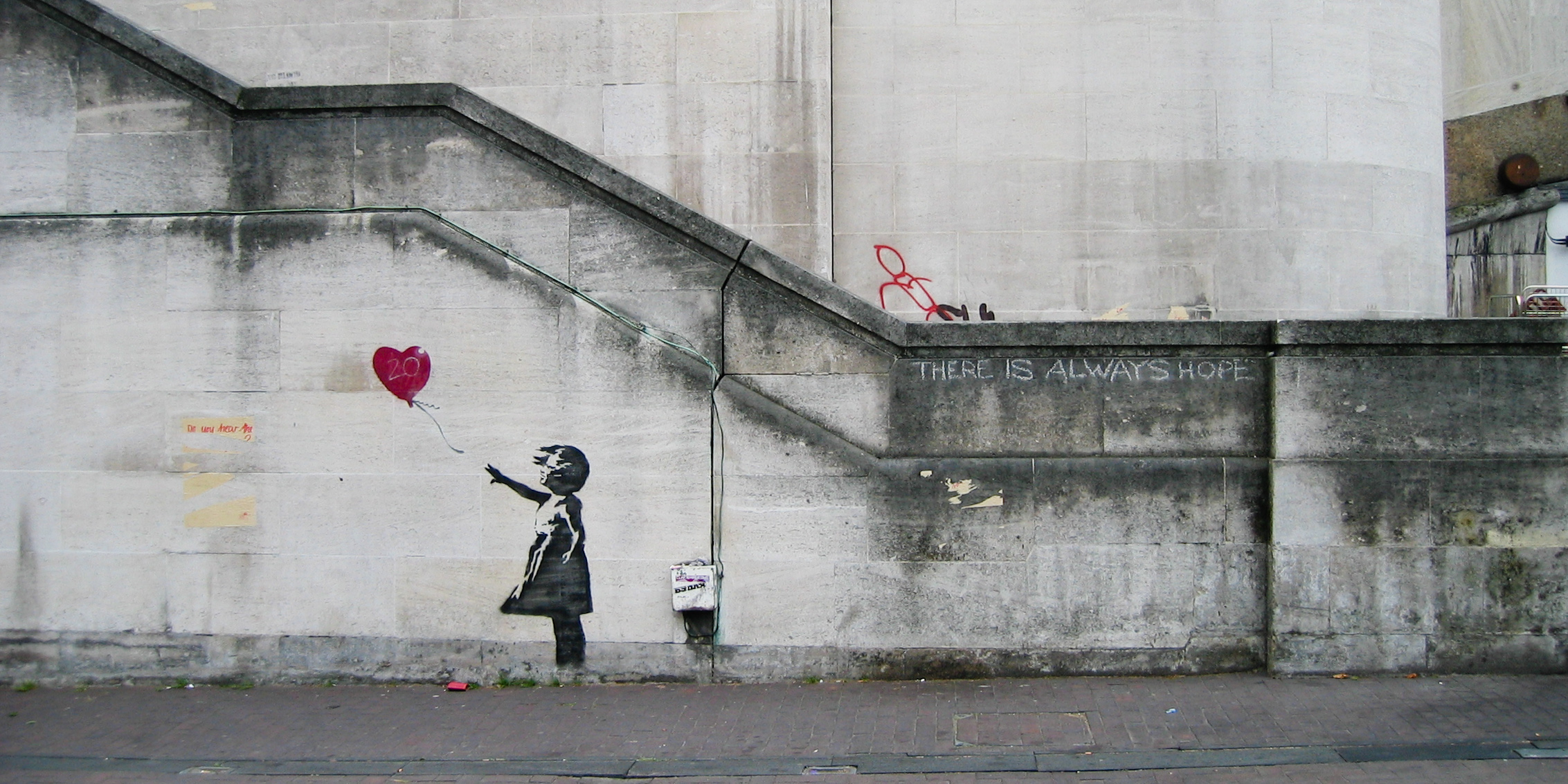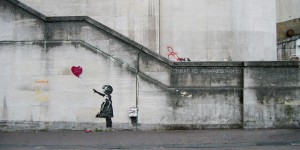“GET BANKSY!” the front page of the New York Post declared, announcing that the New York Police Department had commenced a hunt for the “vandal.” Though the reports of the manhunt for the famed graffiti artist were debunked by Mayor Bloomberg, the headline offers a telling portrait of the tension between street art’s status as an act of vandalism and as a democratic art form. A champion of the “broken windows” theory, Bloomberg criticized Banksy’s presence in New York, saying in a news conference that graffiti is “not my definition of art” and, more abstractly, is “a sign of decay and lost control.”
In spite of Bloomberg’s remarks on the artistry of graffiti—or lack thereof—the general public seems to disagree: Banksy enjoys a reputation as one of the most successful contemporary street artists. The unparalleled accessibility of the medium has driven the rising democratization of art: artists ranging from Bansky to Mark Jenkins are eschewing museums in favor of the streets.
Indeed, at its heart, street art challenges the notion of control and authority. As a medium, the genre deconstructs the confines of “high art,” choosing instead to occupy a space that creates a physical division between the art itself and the institutions it critiques. And from the contrarian underpinnings of the art style emerges a genre rife with sociopolitical commentary.
The Democratization of Discourse
Banksy’s recent residency in New York, titled “Better Out than In,” typifies street art’s growing appeal to the general population, an appeal that has emerged as a consequence of the genre’s commitment to increasing the visibility of art. On his website, Banksy cheekily appropriates Cézanne’s statement that “[a]ll pictures painted inside, in the studio, will never be as good as those done outside.” For street artists, “outside” is more than a physical realm: “outside” is the realm of accessibility, a space where the topics broached by street art can be freely discussed. Maurice Magaña, a visiting scholar at the Institute of American Cultures who studied political street art in Mexico, noted that the genre has facilitated greater participation in political discourse. “You don’t have to be a political or social elite to produce street art. You don’t have the same type of gatekeeping that you have with other types of art,” Magaña explained. And the democratization of discourse extends beyond the production of art. “The scope of the people who are going to encounter [the work] is exponentially greater when it’s done in a public space,” Magaña added. By spatially incorporating the politicized content of street art into the everyday lives of viewers, the medium transforms all viewers into active participants.
The genre’s popular appeal resides in its unique ability to deliver social and political criticism. With its urban grit, the medium’s inherently subversive quality empowers artists like Bansky to embed activist messages within their work. In 2010, Gabriel Specter, a New York-based artist, created a series of bill- boards addressing the gentrification of Brooklyn. “A Nightmare on the Atlantic!” advertised one of Specter’s pieces. “Starring Eminent Domain.” These billboards, placed within Brooklyn, shared wall space with other graffiti, the supposed signs of “decay and lost control.” Yet the subject of Specter’s criticism was not the neighboring graffiti but the socioeconomic forces driving the gentrification of Brooklyn. For street art, the setting is inseparable from the content itself. By physically integrating itself into the community, street art also enters into the community discourse, creating a sense of direct relevance unparalleled by art hung on museum walls.
The democratizing effect of street art extends beyond its physical accessibility: historically, the genre has also served as a venue for marginalized voices. Street art traces its historical roots to urban graffiti and hip-hop counterculture. In a conversation with the HPR, Laurence Ralph, professor of African American studies and anthropology at Harvard, explained that the street art of today is an extension of graffiti art. Its heavily politicized content is a direct consequence of graffiti’s status as “a product from people in marginalized positions who have tried to express themselves and find a voice. Like rap music, street art retains its political context … graffiti is not necessarily political, but it will always have the potential to be.”
The Commercialization of Street Art
Paradoxically, the popular, accessible appeal that characterizes the genre has ushered street art into precisely the same consumerist culture it attempts to critique. Banksy’s installations, including a smashed cinderblock reinterpretation of the Egyptian Sphinx, have been hauled off to be sold on lucrative art markets. His piece “Keep it Spotless” was auctioned off at Sotheby’s for upwards of $1.8 million. The wall paintings that have remained in their original locations have become tourist destinations for fans of the artist. More damningly, major corporations like Nike are increasingly turning to artists like Eric Haze (also known as SE3) to produce branding and marketing campaigns. And Shepard Fairey, famed creator of Obama’s “HOPE” poster, founded the commercially successful clothing line OBEY based off of his art. In a bizarre twist of fate, these artists have financially capitalized on their artwork, pairing with corporations despite the genre’s traditionally anti-corporate stance.
The increasing commercial viability of street art suggests a disruption of the fine balance between the genre’s role as a popular voice and its contrarian identity. Fundamentally, street art is art for the people; arguably, commercial success broadens the reach of the genre and amplifies the sociopolitical commentary it provides. Yet the increasingly ubiquitous appeal of contemporary street art—and the recent bids to capitalize on this appeal—threatens to compromise the integrity of street art’s message. “I think that as this art is co-opted by the capitalist system—this does soften the edges,” Magaña hypothesized. “The more that people are used to seeing these images being used to sell products … the more this detracts from the impact that the art would have otherwise. But at the same time, it’s also exposing more people to legitimize the art form itself.”
Perhaps the rising popularity of street art suggests its induction into the popular canon. Even if the current iteration of high-profile graffiti loses its subversive edge, the medium itself and the criticism it offers will likely remain relevant for decades to come. “There will still be art that people will use to express themselves politically,” Ralph stated. “The graffiti of the ’80s looks nothing like Banksy.” Stylistically, the genre has evolved and will continue to evolve as an art form, but its cultural significance as a medium for marginalized voices and its unique ability to interact with the general public will likely remain constant.
Though currently, the street art scene is dominated by Banksy and his contemporaries, change is forthcoming. In part, this is inevitable—as a medium, graffiti art is inherently dynamic and highly responsive to the physical and political contexts it emerges from. Moreover, the rising popularity of Banksy’s brand of street art foreshadows yet another stage in the evolution of the medium. “A generation from now, there will be something different,” Ralph claimed, predicting that “the graffiti of our generation will become high-class art, just like Basquiat has ascended to the realm of high art.” The commercial success of contemporary street artists suggests that as Banksy moves from the streets to Sotheby’s, new artists, new styles, and new voices of dissent will emerge to populate the space.

